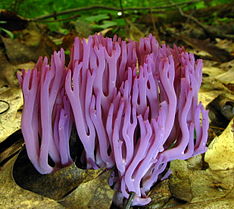- Clavaria zollingeri
-
Clavaria zollingeri 
Scientific classification Kingdom: Fungi Phylum: Basidiomycota Class: Agaricomycetes Order: Agaricales Family: Clavariaceae Genus: Clavaria Species: C. zollingeri Binomial name Clavaria zollingeri
Lév.Synonyms[1] Clavaria lavandula Peck
Clavaria zollingeri, commonly known as the violet coral or the magenta coral, is a widely distributed species of fungus. It produces tubular, purple basidiocarps (fruit bodies) that grow in clusters up to 10 cm (3.9 in) tall and 7 cm (2.8 in) wide. It is a typical member of the clavarioid or club fungi. Clavaria zollingeri is a saprobic species, growing on the ground in woodland litter.
Contents
Taxonomy
The species was first described scientifically by French mycologist Joseph-Henri Léveillé in 1846.[2] It was named after German mycologist Heinrich Zollinger, who researched the genus Clavaria.[3] Clavaria lavandula, named by Charles Horton Peck in 1910,[4] is a synonym.[1] The mushroom is commonly known as the "violet coral",[5] or the "magenta coral".[6]
Description
The fungus produces fruit bodies with a color ranging from violet to amethyst, and dimensions typically 5 to 10 cm (2.0 to 3.9 in) tall and 4 to 7 cm (1.6 to 2.8 in) wide. The stem, or base, is short, and the branching starts a short distance above the ground. In mass, the spores (produced on the surface of the branches) are white. It has no distinguishable odor, and its taste is somewhat like radishes.[6] The edibility is unknown for this species.[3]
The spores are roughly spherical to broadly elliptic, and have dimensions of 4–7 by 3–5 μm.[6] The basidia (spore-bearing cells) do not have clamps, and measure 50–60 by 7–9 μm.[7]
Similar species
Other lavender to violet-colored corals include Clavulina amethystinoides, which is so multiply branched so as to appear toothed, and Clavulina amethystina which can only be reliably distinguished by its two-spored basidia in comparison to the four-spored basidia of Clavaria species.[3] In Alloclavaria purpurea, the branching is reduced and the color usually a duller purple.[8]
Habitat and distribution
The fungus grows solitarily or in clusters on the ground and in grassy spots, usually near hardwood trees.[3] It is a saprobic species,[8] deriving nutrients by breaking down organic matter. It has a widespread distribution, and has been found in Australia,[9] New Zealand,[10] North America,[8] South America,[11] Europe, and Asia (including Brunei[12] and Korea[13]). It is listed in the Danish Regional Red List of threatened species.[14]
Bioactive compounds
Clavaria zollingeri contains lectins, a class of proteins that bind specific carbohydrates on the surface of cells, causing them to clump together. A Korean study demonstrated that extracts of the fungus caused lymphoagglutination, a specific form of agglutination that involves white blood cells.[13] In general, lectins are used in blood typing and serology, and they are widely used in affinity chromatography for purifying proteins.
References
- ^ a b "Clavaria zollingeri Lév.". Species Fungorum. CAB International. http://www.speciesfungorum.org/Names/SynSpecies.asp?RecordID=154126. Retrieved 2010-09-20.
- ^ Léveillé JH. (1846). "Descriptions des champignons de l'herbier du Muséum de Paris" (in French). Annales des Sciences Naturelles, Botanique. III 5: 111–67.
- ^ a b c d Metzler V, Metzler S. (1992). Texas Mushrooms: a Field Guide. Austin: University of Texas Press. p. 248. ISBN 0-292-75125-7. http://books.google.com/books?id=HRtfvVigMmsC&lpg=PA248&dq=clavaria%20zollingeri&pg=PA248#v=onepage&q=clavaria%20zollingeri&f=false. Retrieved 2010-06-25.
- ^ Peck CH. (1910). "Report of the State Botanist. 1909". Bulletin of the New York State Museum 139: 47.
- ^ "Recommended English Names for Fungi in the UK" (PDF). British Mycological Society. http://www.britmycolsoc.org.uk/resources.asp?Cat=Recommended%20English%20Names%20for%20Fungi%20in%20the%20UK%20%20. Retrieved 2010-10-27.
- ^ a b c McKnight VB, McKnight KH. (1987). A Field Guide to Mushrooms: North America. Boston: Houghton Mifflin. pp. 72–73. ISBN 0-395-91090-0. http://books.google.com/books?id=kSdA3V7Z9WcC&lpg=PA71&dq=clavaria%20zollingeri&pg=PA72#v=onepage&q=clavaria%20zollingeri&f=false. Retrieved 2010-06-27.
- ^ Ellis JB, Ellis MB. (1990). Fungi without Gills (Hymenomycetes and Gasteromycetes): an Identification Handbook. London: Chapman and Hall. p. 64. ISBN 0-412-36970-2. http://books.google.com/books?id=vowdIZ7GqD4C&lpg=PA64&dq=clavaria%20zollingeri&pg=PA64#v=onepage&q=clavaria%20zollingeri&f=false. Retrieved 2010-06-27.
- ^ a b c Kuo M. "Clavaria zollingeri". Mushroom Expert. http://www.mushroomexpert.com/clavaria_zollingeri.html. Retrieved 2010-06-26.
- ^ Petersen RH. (1978). "Genus Clavaria in southeastern Australia". Australian Journal of Botany 26 (3): 415–24. doi:10.1071/BT9780415.
- ^ "Family: Clavariaceae". The Hidden Forest. http://www.hiddenforest.co.nz/fungi/family/clavariaceae/clavariaceae.htm. Retrieved 2010-06-26.
- ^ Henao LG. (1989). "Notes on the Aphyllophorales of Colombia Basidiomycetes Aphyllophorales" (in Spanish). Caldasia 16 (76): 1–9.
- ^ Roberts PJ, Spooner BM. (2000). "Cantharelloid, clavarioid and thelephoroid fungi from Brunei Darussalam". Kew Bulletin 55 (4): 843–51.
- ^ a b Jeune-Chung KH, Kim MK, Chung SR. (1987). "Studies on lectins from mushrooms II. Screening of bioactive substance lectins from Korean wild mushrooms" (in Korean). Yakhak Hoeji 31 (4): 213–18.
- ^ "Clavaria zollingeri Lév.". NERI - The Danish Red Data Book. Danmarks Miljøundersøgelser. http://ospm.dmu.dk/1_Om_DMU/2_Tvaer-funk/3_fdc_bio/projekter/redlist/data_en.asp?ID=3946&gruppeID=83. Retrieved 2010-06-26.
Categories:- Agaricales
- Fungi of Asia
- Fungi of Australia
- Fungi of Europe
- Fungi of New Zealand
- Fungi of North America
- Fungi of South America
Wikimedia Foundation. 2010.
